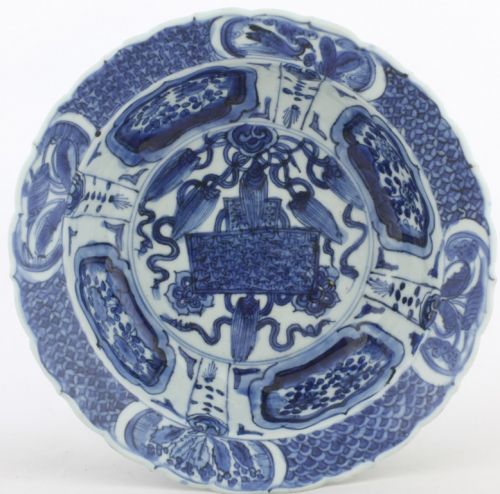
Sold Ceramics - Sold Kraak Porcelain wares 1570-1645 - Klapmutsen
Object 2011626
Klapmuts
China
1595-1610
Provenance: Mr D.H.J. Ninck Blok, Groningen, the Netherlands.
Height 72 mm (2.84 inch), diameter of rim 221 mm (8.70 inch), diameter of footring 99 mm (3.90 inch), weight 505 grams (17.81 ounce (oz.))
Klapmuts or bowl on footring, flat rim with foliated edge. Decorated in underglaze blue with in the centre an unidentifiable rectangle symbolic design with scale patterns (Rinaldi suggests that it might be an embroidered purse) with overhanging tassels and ribbons. The four ogival panels on the sides are filled with floral motifs. The narrow panels, which cover only the sides, have beaded pendants hanging from a ruyi head and ending with a well-drawn tassel. The rim is usually divided into eight sections, four of which are decorated with diapers reserved in white on a blue ground. The fish-scale motif is usually predominant. The four diaper sections frame four reserves filled with flowers motifs and a duck in a pond. On the outside of the rim flowering-prunus-branches. The panels on outside follow the same moulded contour of those inside and have an ogival shape at the top; they are filled with flower and peach sprays. The narrow vertical panels have a lingzhi. The footring has been pierced.
According to Rinaldi this klapmuts can be classified as a group III klapmuts. The rim on this type klapmutsen is usually divided into eight sections, four of which are decorated with diapers reserved in white on a blue ground. the fish-scale motif is usually predominant. The four diaper sections frame four reserves filled with small flower motifs or insects. The four ogival panels on the sides are decorated with very similar delicate motifs. The narrow panels, which cover only the sides, have beaded pendants hanging from a ruyi head and ending with a well-drawn tassel. The centre medallion is very commonly decorated with the deer-in-a-landscape motif. The outside is drawn with complex motifs. The flowering-prunus-branches seems to be the most common decorative motif painted under the rim of the klapmutsen in this group. The panels outside follow the same moulded contour of those inside and have an ogival shape at the top; they are usually filled with peach sprays. The narrow vertical panels have a lingzhi. The preference for the deer motif, coupled with factors such as the delicate flower decorations, the ogival panels and the prunus sprays under the rim, seem to indicate an early date for these pieces of 1595-1610. (Rinaldi 1989, pp.125-127)
A hole has been drilled in the very short footring in order to fit a wire through it - the traditional Dutch way to hang dishes on walls as display pieces. (Rinaldi 1989, p.137)
For similarly decorated objects, please see:
- The ceramic load of the 'Witte Leeuw' (1613), (C.L. van der Pijl-Ketel, catalogue Rijksmuseum Amsterdam, Amsterdam 1982), p.118, inv.no:7741.
- Kraak porcelain. A moment in the history of trade, (M. Rinaldi, Bamboo Publishing Ltd, London 1989), p.110, Pl.105.
- The Wanli Shipwreck and its ceramic cargo, (S. Sjostrand & S. Lok Lok bt. Syed Idrus, Kuala Lumpur, 2007), pp.202-203, Serial no. 6066.
Condition: A chip to the underside of the rim.
References:
Rinaldi 1989, p.60, p.118, pp.125-127, p.137 & Pl.105
Sjostrand & Lok Lok 2007, Serial No. 6066
Price: Sold.


 create websites
create websites